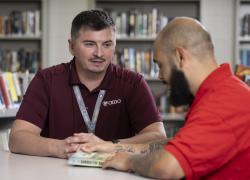How to Prepare Now for the Storm-Induced Power Outages That Are Becoming the New Normal
(NewsUSA) - Storm seasons are getting stronger, longer, and more unpredictable. Whether it’s a thunderstorm knocking out neighborhood power lines, a tornado carving through a region, or a major hurricane threatening the coast, extreme weather can leave millions of Americans in the dark with little warning.
- Storm seasons are getting stronger, longer, and more unpredictable. Whether it’s a thunderstorm knocking out neighborhood power lines, a tornado carving through a region, or a major hurricane threatening the coast, extreme weather can leave millions of Americans in the dark with little warning.
National forecasters are pointing to another above-average hurricane season in 2025, and experts are urging homeowners across the country, not just in coastal areas, to take action now. From spoiled groceries and flooded basements to sweltering homes and equipment failures, power outages can quickly go from inconvenient to dangerous.
In 2024, the U.S. experienced nearly 1.5 billion hours of power outages – the highest year since 2010 when Generac first started tracking this figure.
Now, just one year after Colorado State University predicted a record-breaking Atlantic hurricane season, 2025 is expected to be nearly as powerful with an anticipated above-average season. Now is the time to prepare with a plan to protect your loved ones and your home. This season is predicted to be an above-average hurricane season with an expected nine hurricanes. Four hurricanes are expected to reach major hurricane strength of a Category 3 or higher storm, which creates sustained winds of 111 miles or greater and the great risk of significant loss of life and property damage. But whether you're in the path of a hurricane, a derecho in the Midwest, or ice storms in the Northeast, the reality is clear: every home is vulnerable to outages.
“For many people, the first time they learn about backup power is when they’re already in a crisis,” said Kyle Raabe, president of Consumer Power at Generac Power Systems, a global energy technology company. “Having a plan before severe weather strikes can make a major difference in safety, comfort, and peace of mind.”
Five Ways to Prepare for Power Outages - No Matter Where You Live
Power outage experts from Generac have provided tips on how to prepare for any storm-induced power outages during hurricane season and beyond:
- Create a Storm Safety Plan. Identify the safest spot in your home to shelter in place. Review local evacuation routes and establish a meeting location for family members in case you're separated or need to evacuate.
- Build a Real Emergency Kit. Stock up on essentials: at least seven days of non-perishable food per person, three gallons of water per person, a fully stocked first aid kit, flashlights, extra batteries, and necessary medications.
- Stay Connected During Chaos. Keep phones and electronics fully charged before a storm. Have a battery-powered emergency radio on hand to stay up to date with local alerts and weather updates.
- Secure Backup Power. Consider investing in a portable generator or a whole-home standby system. If you already own one, ensure it’s maintained and ready. Backup power can keep lights on, refrigerators running, operating.
- Know How to Use Generators Safely. Never operate a generator indoors or in enclosed spaces. Keep it far from your home, away from doors, windows, and vents to prevent deadly carbon monoxide exposure.
It Only Takes One Storm
While forecasts grab headlines with big numbers, the truth is that it only takes one storm in the right place to cause life-altering damage. Power grid reliability is already a concern in many parts of the U.S., and storm-related outages are expected to rise with climate shifts.
To help residents and communities prepare, Generac offers readiness resources, including its Hurricane Preparedness Guide that has printable inventory checklists, comparisons on backup power options and power outage safety tips, available at https://www.generac.com/hurricane-prep.


 - Historically, athletic eyewear was mostly relegated to high-impact sports—goggles for the slopes, wraparounds and shields for cycling, or protective frames for basketball. In today’s performance-driven world, it’s no longer just about function or fashion—it’s about both. As the eyewear industry continues to evolve, optical frames are being designed with movement in mind, catering not only to elite athletes but to anyone living an active, on-the-go lifestyle. More brands, like
- Historically, athletic eyewear was mostly relegated to high-impact sports—goggles for the slopes, wraparounds and shields for cycling, or protective frames for basketball. In today’s performance-driven world, it’s no longer just about function or fashion—it’s about both. As the eyewear industry continues to evolve, optical frames are being designed with movement in mind, catering not only to elite athletes but to anyone living an active, on-the-go lifestyle. More brands, like 
 - It's tax season and consulting firms are touting their quick and easy services to relieve the stress caused by filing complex returns.
- It's tax season and consulting firms are touting their quick and easy services to relieve the stress caused by filing complex returns.
 - U.S. energy demand is surging at an unprecedented rate. With economic growth, technological advances, and industrial expansion, our country’s energy demand is projected to grow by between 35% and 50% by 2040, potentially outpacing supply growth.
- U.S. energy demand is surging at an unprecedented rate. With economic growth, technological advances, and industrial expansion, our country’s energy demand is projected to grow by between 35% and 50% by 2040, potentially outpacing supply growth.
 - We are in an era of unprecedented energy demand growth, driven in large part by the rise of artificial intelligence, the rapid expansion of data centers and an unprecedented increase of American manufacturing. Clean energy is now the fastest-growing source of new power in the U.S., and meeting this rising demand will require a diverse, reliable mix of energy resources.
- We are in an era of unprecedented energy demand growth, driven in large part by the rise of artificial intelligence, the rapid expansion of data centers and an unprecedented increase of American manufacturing. Clean energy is now the fastest-growing source of new power in the U.S., and meeting this rising demand will require a diverse, reliable mix of energy resources.
 - The American energy landscape is evolving, and with it, new opportunities are emerging for economic growth, job creation, and energy independence. Offshore wind energy stands out as a transformative solution, capable of revitalizing communities and securing a sustainable future.
- The American energy landscape is evolving, and with it, new opportunities are emerging for economic growth, job creation, and energy independence. Offshore wind energy stands out as a transformative solution, capable of revitalizing communities and securing a sustainable future.
 - There is broad agreement across party lines that it takes too long to build anything in the United States. A new energy generation project, like a solar or wind farm, that needs a federal permit takes an average of 4.5 years to secure it. Projects that only need state or local permits can go faster but still take unnecessarily long.
- There is broad agreement across party lines that it takes too long to build anything in the United States. A new energy generation project, like a solar or wind farm, that needs a federal permit takes an average of 4.5 years to secure it. Projects that only need state or local permits can go faster but still take unnecessarily long.
 - At first glance, a golf ball may seem simple, but OnCore Golf has proven there's much more to it than meets the eye. This innovative startup has revolutionized golf ball technology in ways that larger companies haven't been able to.
- At first glance, a golf ball may seem simple, but OnCore Golf has proven there's much more to it than meets the eye. This innovative startup has revolutionized golf ball technology in ways that larger companies haven't been able to.
 - Many small, family-owned farms in America are struggling to make ends meet. But some farmers like Byron Kominek are discovering how renewable energy can help them keep their land and their way of life.
- Many small, family-owned farms in America are struggling to make ends meet. But some farmers like Byron Kominek are discovering how renewable energy can help them keep their land and their way of life.
 - From charging our phones to fueling up for family road trips and heating our homes, nearly everything we do uses energy. It’s critical to daily life and a prosperous future. With that in mind, Congress created new energy tax credits in 2022 that lay the foundation for generational investments in all energy to meet growing demand.
- From charging our phones to fueling up for family road trips and heating our homes, nearly everything we do uses energy. It’s critical to daily life and a prosperous future. With that in mind, Congress created new energy tax credits in 2022 that lay the foundation for generational investments in all energy to meet growing demand.



